|
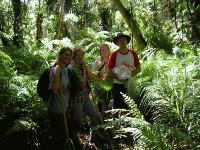 Field
Trip To Lake St. Lucia Field
Trip To Lake St. Lucia
KwaZulu-Natal Province
South Africa
By Jacques Gerber - Click images to
enlarge
Jacques Gerber is a wetland ecologist, currently
studying for his PhD in Botany at the University of Pretoria,
South Africa.
In late March of 2003, I went with several others to do fieldwork
at Lake St. Lucia, , in an area of swamp forest. Nymphaea
capensis, N. caerulea and N. lotus have all
been recorded in the area and are found throughout the region.
The N. caerulea in the area are more blue than the ones
I collected last year at Rust-der-Winter, and the N. capensis
have been recorded as being pink. N. lotus is rare in
the area but is found.
"Many millions of years ago, the flat coastal plain of Zululand
lay beneath the sea. When the waters receded for some unknown
reason, they left a broad sandy terrace of about 100 km wide.
Rivers now found themselves with a new obstacle, and they began
to form a system of lakelets on the sandy plain. The wind created
a ridge of sand-dunes along the new coast, hampering the rivers
even further from reaching the sea. Several combined to form
the huge shallow estuary system known as Lake St Lucia, the largest
salt-water body in Africa." First paragraph of The Story of St. Lucia
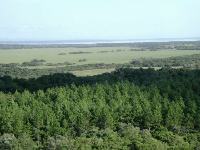 |
Swamp, Lake and Plantation
This picture shows a small patch of indigenous dune forest in
the foreground, then a pine tree plantation, some more forest,
the swamp, a patch of swamp forest, and Lake St. Lucia in the
background. The area that looks like a grassland is the swamp.
The pine plantations date from before the area was proclaimed
as a world heritage site. They are being allowed to mature, and
are then clear cut, allowing the natural forest to restore itself. |
 |
Rhynchospora and Fimbrostylis Peat Swamp
Water here varies from 10 cm to 60 cm. Some Utricularia and
even a young waterlily or two occur here, as do several other
sedge, and two grass species. The line of trees in the distance
is two kilometres away. That area is a Sphagnum peat swamp
forest. |
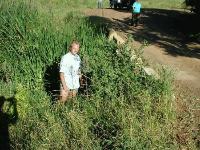 |
Ludwigia
This picture shows me with a large Ludwigia. It's next
to a small bridge spanning a stream through a narrow strip of
Barringtonia riverine peat forest. The clothes I'm wearing
are due to the need to go wading, and the collared shirt is normal
field wear for experienced ecologists - collar keeps the sun
off your neck, and the button up front helps you to keep cool. |
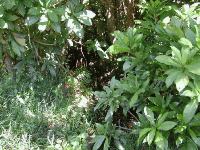 |
Barringtonia Swamp
This picture was taken at a narrow point along the Barringtonia
riverine swamp forest where a bridge crosses the main stream. |
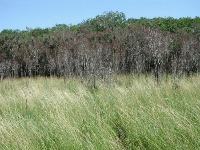 |
Dead Sysigium and Andropogon
This is the very edge of the swamp after the first crossing.
The Sysigium are the dead trees, which were killed by
the last fire, while Andropogon is the grass. This area
is part of the Sphagnum peat swamp community. |
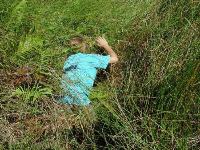 |
Ina Venter in the Eleocharis swamp
She's standing in a hippo track, roughly knee deep in water.
The peat swamp is her MS project study site. The darkish green
reed on the right is Eleocharis, though I don't know which
species. I collected Nymphoides thunbergiana here, as
well as a crop of leeches. |
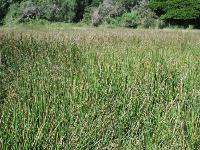 |
Eleocharis Swamp
This area is a smaller swamp within the main swamp complex. The
whole area is criss-crossed by hippo trails which form deep channels.
It was very dry when we were here, with Nymphoides plants
actually growing out of the water in some places. The water here
is infested with leaches. |
 |
"Ina Innit"
This gives an idea of the height of the Eleocharis here.
Ina is about the same height as me - 176cm. |
Page 2>
Profile - Jacques Gerber
|
 Field
Trip To Lake St. Lucia
Field
Trip To Lake St. Lucia






